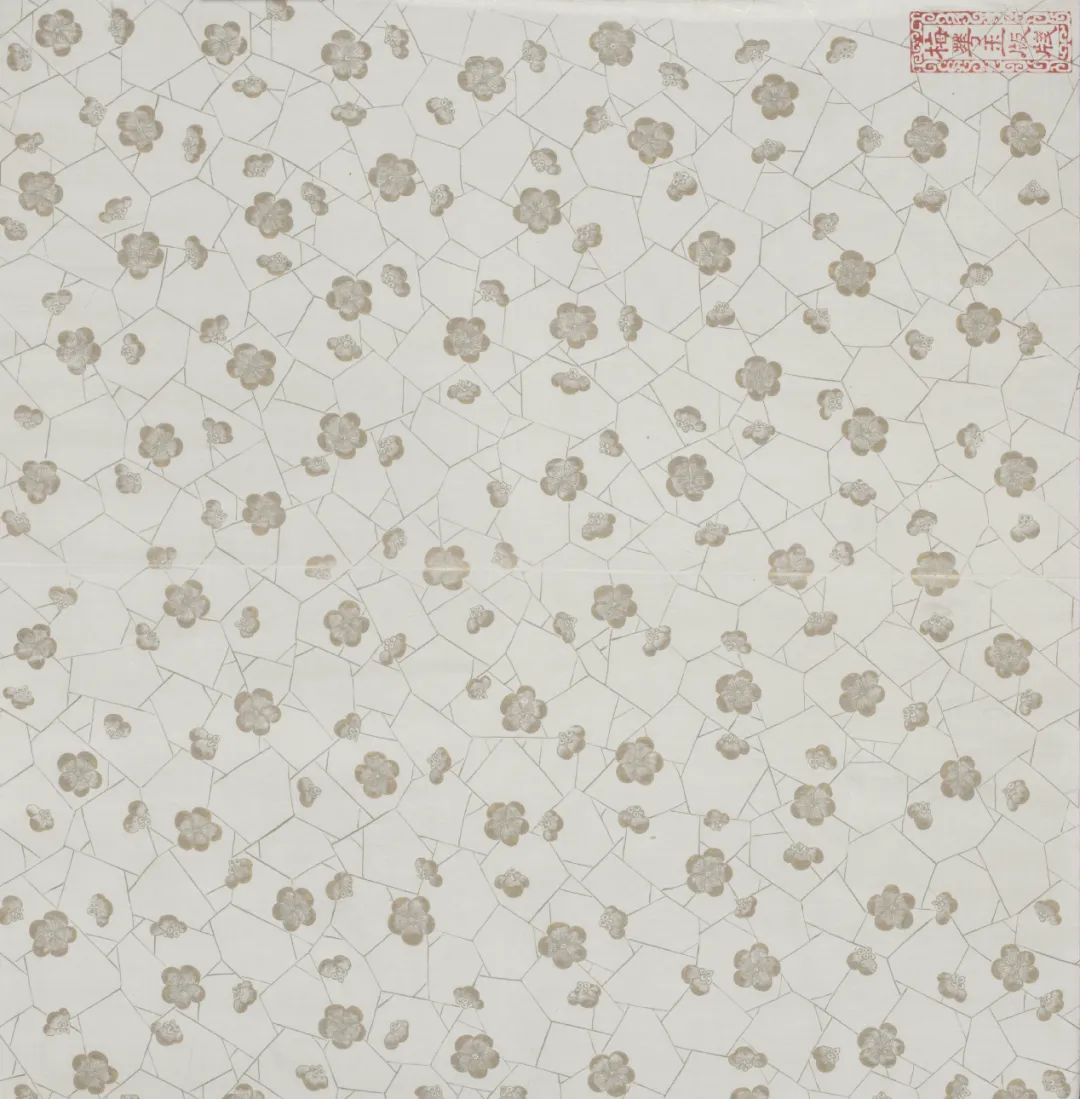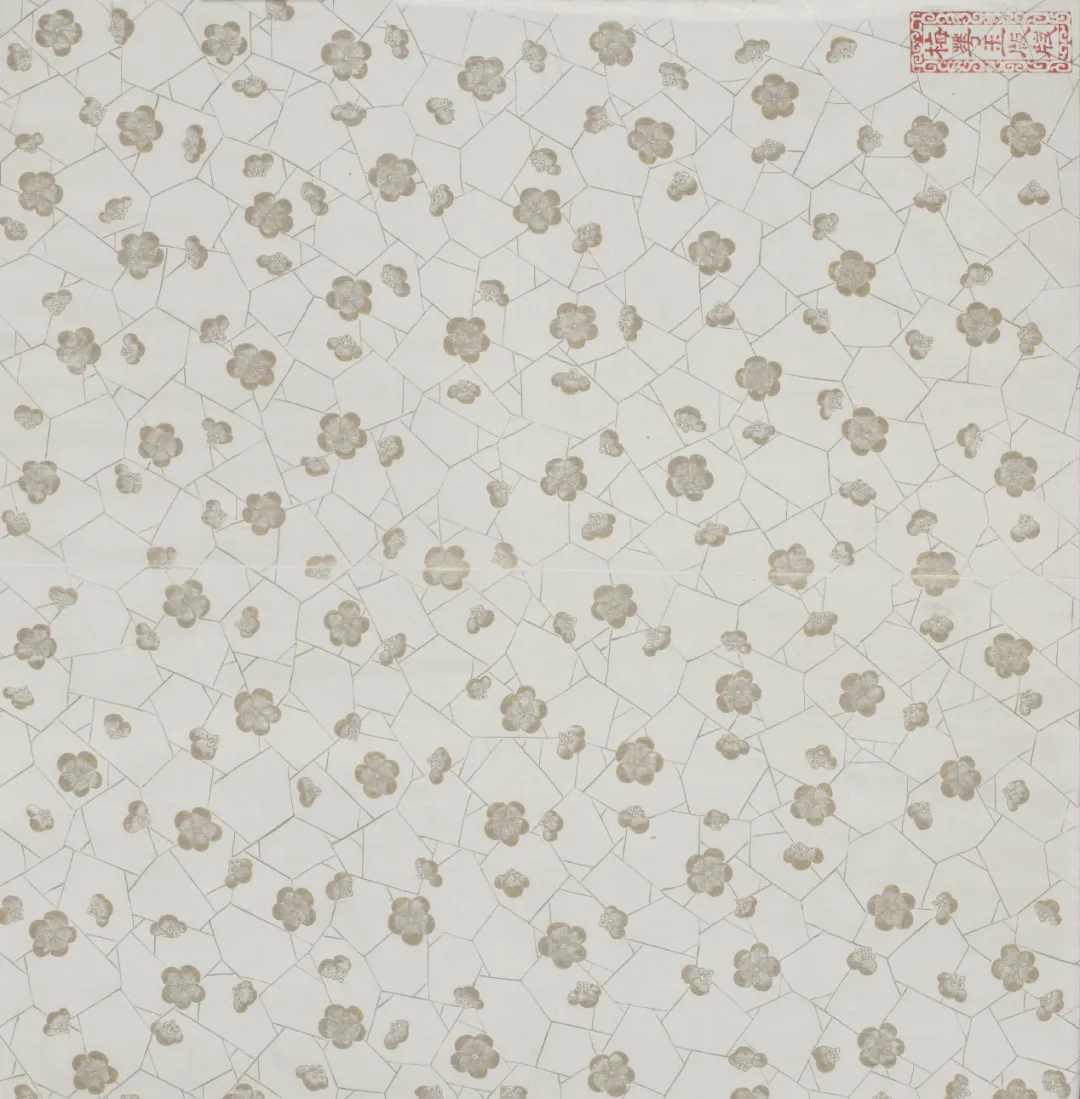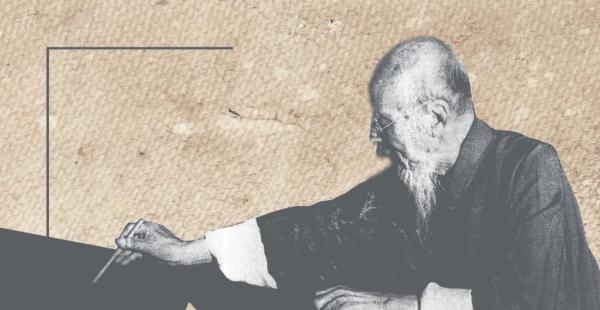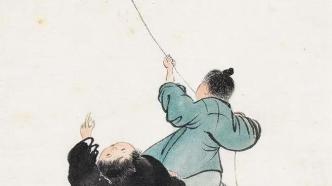
Qingming happens every year, and Qingming happens again today. During the Qingming Festival, in addition to tomb sweeping and ancestor worship, there are actually activities such as willow planting, outing, Cuju, kite flying, and cockfighting. There are many records of this in ancient documents and cultural relics, calligraphy and paintings that have been handed down to this day. For example, the kite cultural relics collected in the Forbidden City, Cuju pictures and cockfighting pictures in ancient paintings all bear witness to the customs of the Qingming Festival.
It is recorded in "Qing Jia Lu" of the Qing Dynasty: "The wind of spring comes from bottom to top, and the kites rise because of it, so there is a proverb of 'fly the broken harrier during the Qingming Festival'." According to the old custom, during the Qingming Festival, the kites can be cut after being flown into the blue sky. Pulling strings and letting the kite float away in the wind means that all diseases and bad luck will go away from you, so it is also called "letting the kite fly away". "Qing Jia Lu" says: "The spring breeze comes from bottom to top, and paper kites rise due to it, so there is a proverb of 'The broken harriers are released during the Qingming Festival'."
Following the previous release of "Twenty-Four Solar Terms in Poems and Paintings", The Paper Art has launched "Twenty-Four Solar Terms in Landscapes and Objects" starting today, tracing the beauty of the scenery and objects in the twenty-four solar terms among traditional folk customs, cultural relic collections and ancient calligraphy and painting.
Kite
As a kind of folk art, Chinese kites have a history of more than 2,000 years. It is said that during the Spring and Autumn Period and the Warring States Period, Mo Zhai made wooden birds from wood. The development was completed in three years. It was the earliest origin of kites. Later, Lu Ban made wooden birds from bamboo. Improve. The material of Mo Zhai's kites has evolved into today's multi-thread kites. During the Eastern Han Dynasty, after Cai Lun invented papermaking, he began to make kites from paper, called "paper kites".
In the Tang Dynasty, kite flying had become a very common entertainment activity. Both the people and the court showed a strong interest in kites. According to "Chinese Dragon Culture and Dragon Sports" (Tianjin Ancient Books Publishing House), Ludyan described various children's games in the Tang Dynasty in "Fifty Rhymes of Children's Poems", including bamboo horses, hidden hooks, swings, grass fighting, and kicking. Balls, paper kites, etc. In 713 AD, Li Longji, Emperor Xuanzong of the Tang Dynasty, watched the flying of the "Eight Immortals Crossing the Sea" kite in the Yichun Courtyard of Penglai Palace in Shandong. The production level of kites in the Tang Dynasty was very high, and they were generally designed to simulate the shape of birds. With the development of the paper industry, paper kites gradually emerged in the Tang Dynasty, and some court kites were made of silk. Not only can some kites be flown during the day, but at night, colorful lanterns can be hung on the kites and placed into the night sky. The lanterns will swim through the night with twinkling lights and shadows, which is quite spectacular. There is a record of a kite flying into the night sky in "Xi Deng Yao Wen" written by Zhao Xin of the Tang Dynasty: The bright lanterns swim in the sky, like sky lanterns, rising and falling, endless changes, and unique interest.
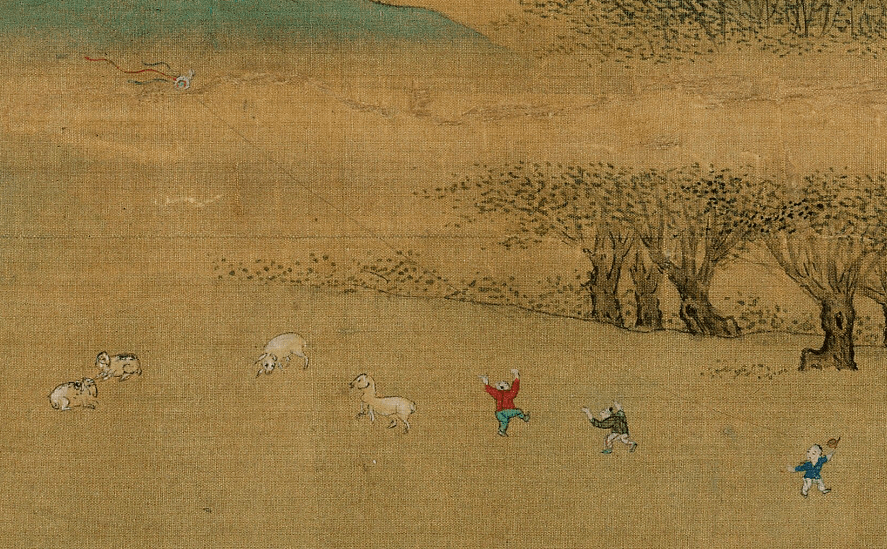
Kite flying in "Along the River During Qingming Festival" by Qiu Ying of Ming Dynasty (detail)
As late as the Song Dynasty, it was popular to fly kites during the Qingming Festival. It is recorded in "Old Wulin Stories" of the Song Dynasty: "During the Qingming Festival, kites are released in the suburbs and they return home at dusk." "The Records of the Years in the Imperial Capital", which records Beijing folk customs, records: "When sweeping tombs during the Qingming Festival, alluring men and women go out to the suburbs one after another to carry wine and pick up boxes. , the wheel hubs look at each other. Each carries a spool of paper kite, and after the sacrifice is completed, it is cast in front of the tomb to see which one is the winner."
During the Qing Dynasty, kite-making became increasingly sophisticated, and different regional styles were clearly formed, and a number of famous kite-making experts emerged. For example, Beijing's "Kite Ha" (Ha Guoliang) and "Kite Jin" (Jin Fuzhong), Tianjin's "Kite Wei" (Wei Yuantai), etc., not only did they dominate for a while, but they also had successors and formed their own schools. Beijing is the capital of kites in the country. Not only are the kites well-made, but the kite market is very prosperous. Yangzhou kites were relatively famous in the Qing Dynasty, and the special feature is that the kites are equipped with bow strings and other sound devices. Tianjin's kites draw on the strengths of many experts. Forming a fresh, lively, and colorful style; Weifang kites became famous at home and abroad in the Qing Dynasty for their strong local color and folk flavor, among which Yangjiabu was the most famous. As early as the Qianlong period, there were more than 30 painting shops in Weifang engaged in kite making, with an annual output of 40,000 kites. During the Daoguang period, the annual sales volume reached 200,000 kites.

Folk kites collected by the National Art Museum of China
In traditional Chinese kites, auspicious meanings can be seen everywhere: "good fortune and longevity", "dragon and phoenix present auspiciousness", "a hundred butterflies making spring", "carp jumping over the dragon gate", "Ma Gu offering longevity", "a hundred birds paying homage to the phoenix", "fishes all year round" These kites such as "Four Seasons of Peace" all express people's yearning and longing for a better life. By the Northern and Southern Dynasties, kites began to become a tool for transmitting information; starting from the Sui and Tang Dynasties, due to the development of the paper industry, people began to use paper to decorate kites; by the Song Dynasty, kite flying became a favorite outdoor activity.
Paper catfish kite
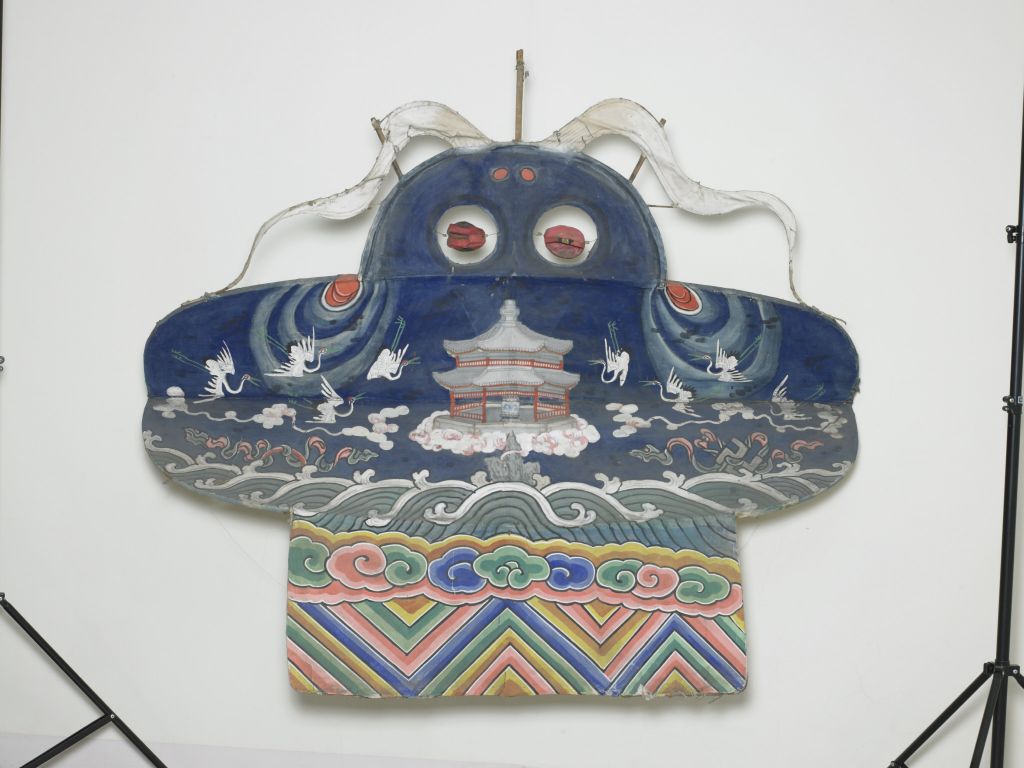
Paper catfish kite, Qing Dynasty, 114 cm high and 80 cm wide. Collection of the Palace Museum.
This catfish-style kite is collected by the Palace Museum and has the meaning of "abundance every year". The main pattern of the kite is the "Sea House Adding Chips" which means birthdays: the center is the Temple of Heaven, and inside the altar is a small house, which means the Sea House, with a vial containing chips; around the Temple of Heaven are 8 dancing cranes, all holding chips in their mouths , want to build a house on the sea. The auxiliary pattern of the kite is a painted picture of sea water and river teeth. The fish eyes of the kite can move, and the long and curved fish whiskers at the top can dance in the wind.
The kite combines warm and cold tones with strong color contrast, and the picture is full of a warm and cheerful atmosphere.
Paper dragon-shaped kite
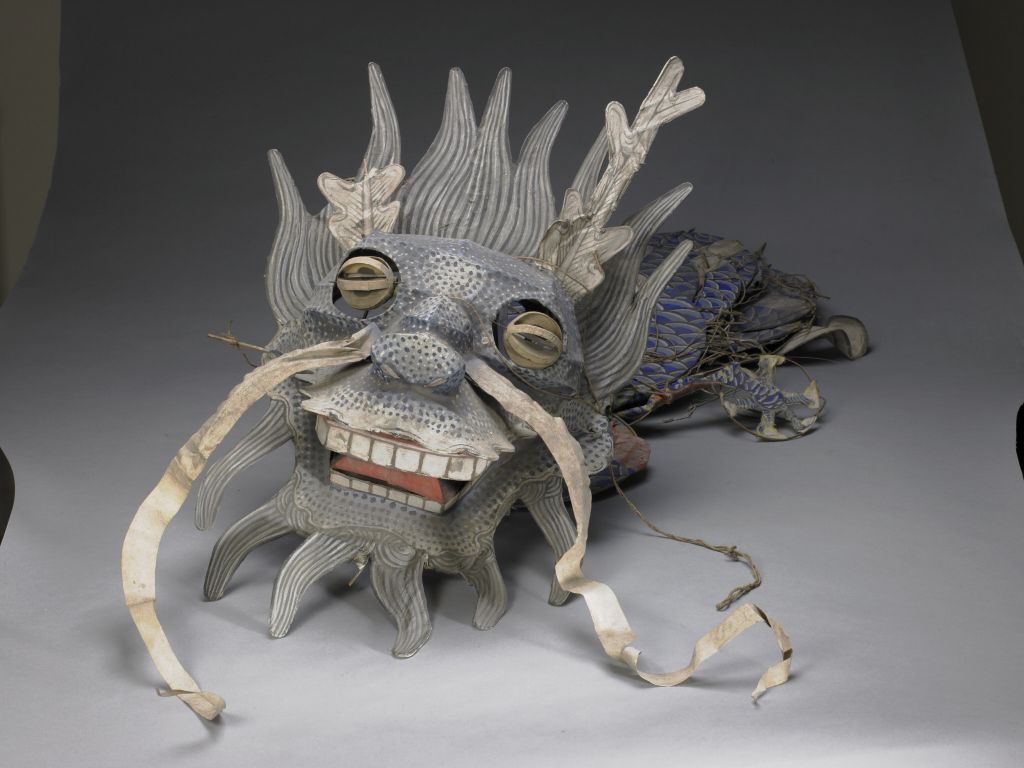
Paper dragon-shaped kite, late Qing Dynasty, 13m long and 2.7m wide. Collection of the Palace Museum.
Paper dragon-shaped kites were used in court games in the Qing Dynasty. The kite is in the shape of a dragon, with a huge dragon head and a majestic shape. The dragon's beard is thick and slender, chic and unique, and its eyes are movable, which adds aura to the kite. There are more than ten scales on the faucet head, with bright and natural colors. The dragon body is slender, with blue scales all over its body, and the pattern is fresh. The interior is connected with strings and has a fine structure. The dragon's claws are in the shape of a wave wheel and are powerful. This kite is huge in size and is a fine product among the game equipment of the Qing Dynasty.
Natural color yarn and embroidered spring cow picture scroll
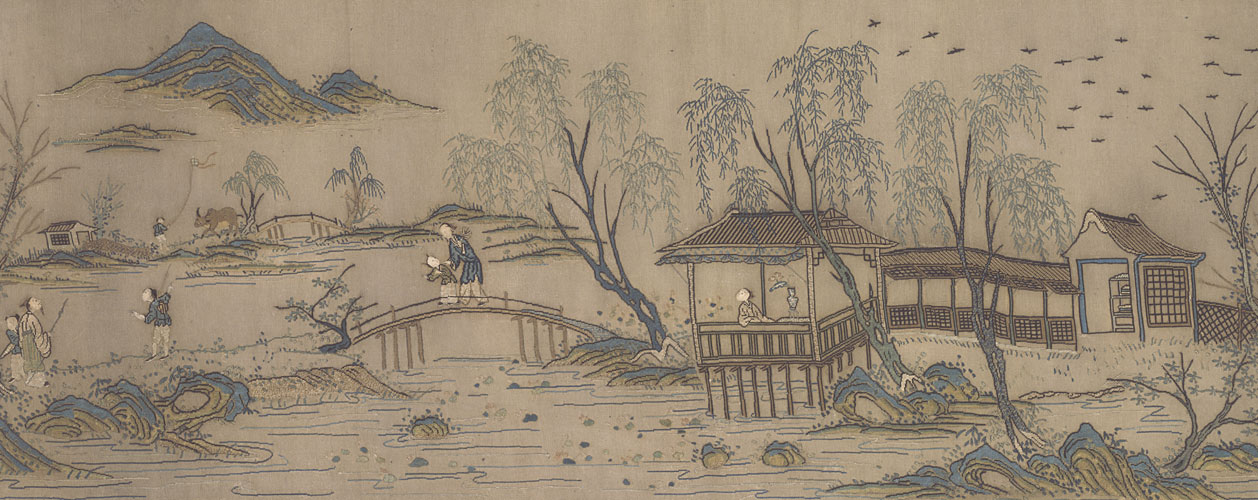
Scroll of natural color gauze and embroidered spring cow, Qianlong period of the Qing Dynasty, 35 cm in length and 92 cm in width.
This picture scroll is embroidered with patterns such as distant mountains, flying dragons, small bridges and flowing water, cloisters and waterside pavilions, trees, figures, slopes, flowers and plants on the plain square hole gauze ground. The work adopts a decorative method of one or two colors, and is embroidered with diagonal string, flat stitch, trocar stitch, flat gold and other stitches. The layout has absorbed the "scattered point perspective" of traditional painting, and successfully used the panoramic composition of the "Three Distances" of Chinese painting, organically combining the flat distance, the high distance and the far-reaching, with ingenious layout and opening and closing. There is a degree. The characters in the painting are independent, but also have some internal connection. For example: the eyes of the characters on the waterside pavilion in the close shot are attracted by the kite in the hands of the shepherd boy in the distance, and the forgetful expression of looking back and twisting the neck is vividly depicted. In the work, the embroiderer also skillfully used the color combination method of plying different-colored silk threads to fully express the light and dark textures of the weathered slopes and tree branches.
This work has a beautiful composition and delicate and expressive embroidery work, reflecting the maker's meticulous observation and capturing ability of nature and cultural landscapes.
The spring breeze paper kite written by Qi Baishi and Pu Xinshe
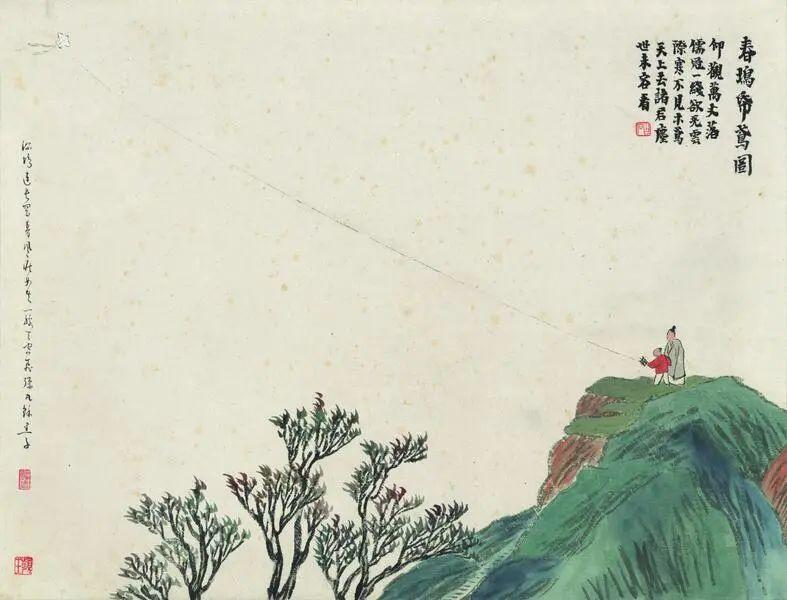
Qi Baishi's "Spring Festival Paper Kite" is now in the Liaoning Provincial Museum
Qi Baishi's "Spring Festival Paper Kite" is now in the Liaoning Provincial Museum and is one of Qi Baishi's "Twenty-Four Scenes of the Stone Gate". The painter used a freehand brushwork to depict the green cliffs and rocks, with a tree crown next to it full of leafy branches, lush green trees, and full of vitality. On the rocks, the kite in the hands of a young man in red has floated high into the sky, and another old man in brown seems to be instructing the children to fly the kite. There is an inscription on it: "Looking up at the crown of Confucianism falling thousands of feet, a thread is about to fly across the cold clouds. There is no wooden kite flying up to the sky. You have never seen it in this world."
In 1910, Hu Lianshi, a famous scholar in Xiangtan, asked Wang Zhongyan to draw up 24 titles for the scenery near Shimen where he lived, and then commissioned Qi Baishi to paint according to the titles. Qi Baishi carefully conceived and revised his drafts several times, and it took him more than three months to complete "Twenty-Four Scenes of the Stone Gate".
Another piece of Qi Baishi's "Innocence: Five Children's Paper Kite" collected by the Liaoning Provincial Museum was painted in 1940 when Qi Baishi was around 80 years old. In the picture, five innocent and lively children are in a circle, but with different postures. The whole painting is vivid and vivid. Qi Baishi extremely vividly captured the innocent fun of a group of children flying kites. The kites flying in the sky echo the children at the bottom of the picture, forming changes in density, opening and closing, creating a contrast between loneliness and the crowd, which can't help but bring out the childlike innocence and return to the "innocent" years.

Qi Baishi's "Innocence: Five Children's Paper Kite"
Pu Xinshe, a famous modern calligrapher and painter, also loved kite-themed paintings. Pu Xinshe (1896-1963), great-grandson of Emperor Daoguang of Xuanzong of the Qing Dynasty, second son of Prince Gong Yixin, second son of Zaiying, cousin of the last emperor Puyi, surnamed Aixinjueluo, given name Puru, first given name Zhongheng, changed name Xin She, also known as Xishan Yishi, Xi Huangren, Jiu Wangsun, etc., also known as Han Yutang, moved to Taiwan, China in 1949, and lectured at Taiwan Normal University, Hong Kong New Asia College and other schools.

"Spring Breeze Full of Suburbs" by Pu Xinshe
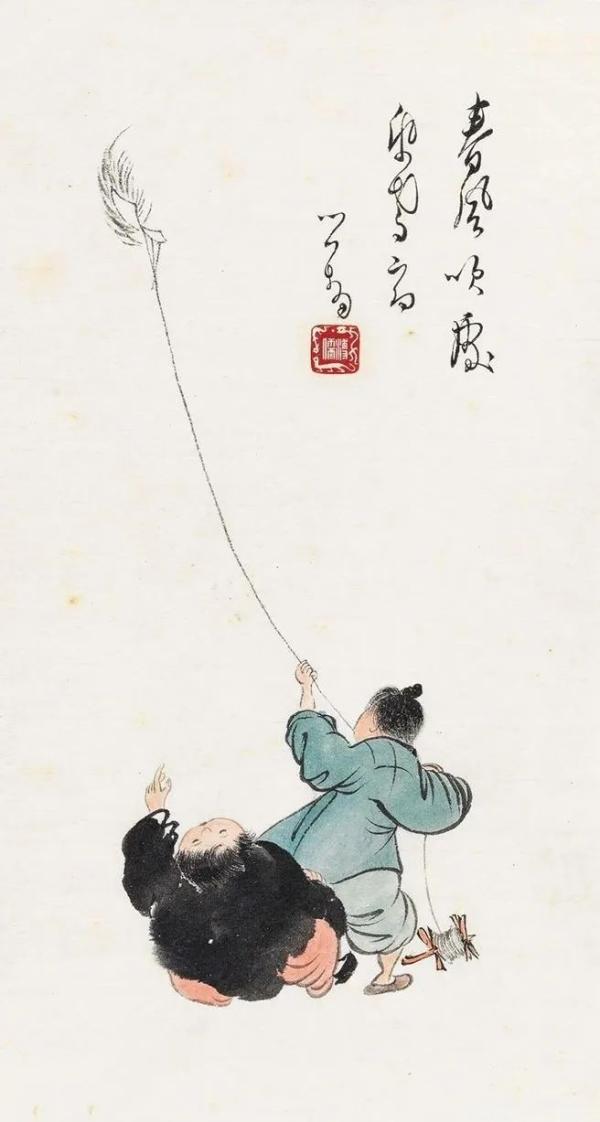
"Where the Spring Breeze Blows" by Pu Xinshe
Kite in Dunhuang suicide note
It can be seen from ancient literary records that kites are closely related to organs and Tianle. For example, the Dunhuang posthumous document S.5511 "Conquering Demons and Bianwen" contains: "Qins and zithers hang at the four corners." The "Tianle" image in the Dunhuang murals flies in the air and sings without drums, which is influenced by kites.
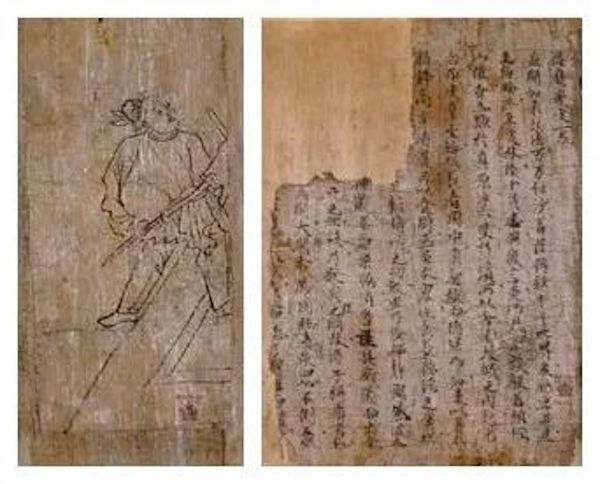
Kite "Conquering Demons and Bianwen" Dunhuang Document S.5511 Dunhuang Academy Picture
Flying a kite is highly entertaining. When flying, you can welcome the good weather and keep your concentration while pulling the string, which improves your eyesight and strengthens your body. People bathe in the sunshine, breathe fresh air, and run around in the wilds and squares, stretching and relaxing. Therefore, flying kites has the effect of refreshing and practicing, and complementing each other. Especially today, when many traditional games have been lost, kites have "flyed" all the way with the spring breeze from history, and have become a great success. Today, they have become a "sunshine sport" favored by many people, and become people's fitness, entertainment, A casual way to make friends.
fighting birds
Cockfighting is an activity in which animals are trained for competition. It is also a worldwide game and entertainment project. It became popular in my country as early as the pre-Qin period.

Cockfight, Dunhuang Mogao Grottoes, Cave 285, South Wall, Western Wei Dynasty
Dunhuang Document P.3608 "Cold Food Chapter" records: "We fight Runan chickens together in the flower shop, and travel all over the eastern suburbs in spring." S.6171 "Gong Ci Congchao" records: "Move the east side of the imperial building to the house , cockfighting ground in Shaoyang Palace." In addition to documentary records, stone portraits with cockfighting scenes were found in Han tombs excavated during archaeological excavations. There is a vivid picture of a cockfight on the south wall of Cave 285 of the Western Wei Dynasty in the Mogao Grottoes in Dunhuang.
Cockfighting has a long historical process, from the pre-Qin Dynasty through the Han and Tang Dynasties to the Song, Yuan, Ming and Qing Dynasties. It lasted more than 2,500 years and evolved into a national custom. People not only created unique domestication techniques, improved the rules of cockfighting, invented some special "tactics" and "tactics" for cockfighting, and built special "cockfighting grounds", but also based on the rules of "cattle" and "friendship" during cockfighting. "With the requirement of deciding the outcome, the guild organizations and apprenticeship factions of cockfighting emerged, as well as a large number of poetry and prose works.
Cuju
Cuju has been popular since the Qin and Han Dynasties, and became an important military training in the Han Dynasty and an important means to improve the physical fitness of soldiers and to entertain their bodies and minds. When the Han general Huo Qubing was stationed in Hexi, he personally led his soldiers to practice Cuju. The Cold Food Cuju activity on the Silk Road has gone through thousands of years of development, and its forms, methods, rules, etc. have all changed. For example, Cuju during the Han Dynasty was mainly used as a means of military practice. During the Sui and Tang Dynasties, Cuju skills were greatly improved, and inflated leather balls appeared. From the Spring and Autumn Period and the Warring States to the Han Dynasty, many Cuju cultural relics have remained, such as stone carvings, bronze mirrors, silk books, silk paintings, sculptures, ceramics, murals, etc. Among the famous paintings depicting Cuju, "Picture of Cuju Cuju" by Qian Xuan of the Yuan Dynasty is very famous.
Cuju, also known as Cuju, was popular in the Tang Dynasty. The Song Dynasty's "Wenwen Tongkao" records: "Cuqiu began to be played in the Tang Dynasty. Two bamboos were planted, several feet high, and a net was placed on top to serve as a door to measure the ball. The ball work was divided between left and right friends, and the victory was won by horns." History records the virtues of the Tang Dynasty Zong, Xianzong, Mu Zong and Jingzong all liked to play kickball, but the emperors of the Song Dynasty were even worse.

"Pictures of Cuju played by Emperor Taizu of the Song Dynasty"
The original picture of the "Cuju Picture of Taizu of the Song Dynasty" was painted by Su Hanchen, a famous painter in the Song Dynasty. Qian Xuan wrote after copying it: "The picture of Cuju was kept in the secret house in the past, and I copied it now. If it is not a revolution between heaven and man, we should not look at it, and how can we paint it." "It shows his long-standing admiration for this painting. On the right side of the painting, the person on the right side of the painting is short and fat, wearing a scarf, a hat, and casual clothes, and is playing football. On the opposite side of Taizu, the person with a beard, wearing a high hat and robe, holding the corner of his robe to catch the ball is Zhao Pu; Zhao Pu Behind him are Chu Zhaofu, who is young and beardless and dressed similarly. Behind Chu Zhaofu, there are three people side by side, from left to right, namely Shi Shouxin, Song Taizong (Zhao Kuangyi), and Dang Jin.

Part of "The Song Taizu Cuju Picture"
Tang Wenfeng of the Ming Dynasty wrote a poem titled "Cuju Tu" in "Wugang Collection". The poem explains that the first two people playing football were Song Taizu Zhao Kuangyin and his younger brother Song Taizong, and the last four people watching were ministers Zhao Pu, Chu Zhaofu and Dang Jin. , Shi Shouxin, all contributed to the founding of the Song Dynasty, and they all liked to play football; "When Ming and Liang met at the same time, they took leisure time and had fun with each other, and it was also appropriate to have fun in the army." This picture shows that Cuju was an important part of the army in the early Song Dynasty. Zhongzhile was an activity loved by the founding emperors and nobles of the Song Dynasty. It is recorded in "Old Wulin Events" that in the Song Dynasty, in addition to official Cuju artists, there were also folk Cuju artists performing on tiles. The most widely carried out folk activity in the Song Dynasty was the "Cold Food Cuju"; "Cold Food Cuju" in Liangzhou Ten Among thousands of families, Cuju swing is still luxurious." In this atmosphere of football craze from top to bottom across the country, there are figures such as Gao Qiu, Zhang Ming, Liu Sanfu, etc. who made their fortunes due to playing football.
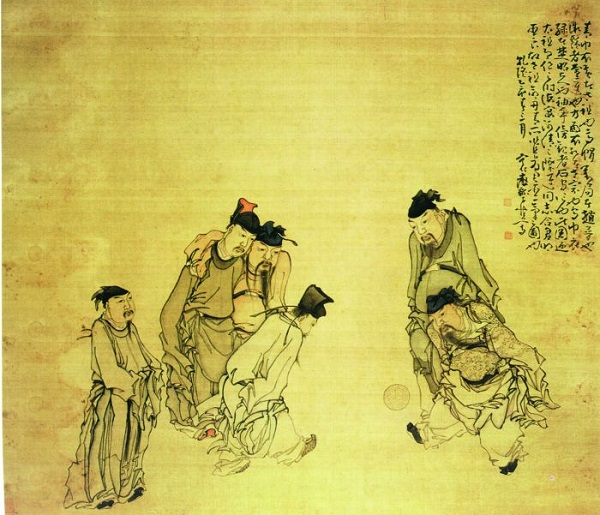
"Cuju Picture" by Huang Shen of the Qing Dynasty

The Cuju scene in "Ladies Pictures" by Du Chan of the Ming Dynasty

Children’s Cuju scene in ancient paintings
In addition to Qian Xuan, there are many paintings in later generations that show the activity of "Cuju". They not only depict scenes of royal nobles, literati and officials playing Cuju, but also scenes showing women and children playing Cuju. For example, Shang Xi's "Xuanzong's Happy Picture" of the Ming Dynasty, Huang Shen's "Cuju Picture" of the Qing Dynasty, Du Chan's "Ladies Picture Scroll" of the Ming Dynasty, Su Hanchen's "Changchun Hundred Sons Picture" of the Northern Song Dynasty, etc.
(Note: This article is based on a comprehensive collection of relevant graphic and textual materials from the Palace Museum, National Art Museum of China, Liaoning Provincial Museum, Dunhuang Academy, and The Paper)
